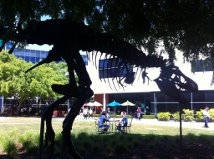Palo Alto, 29.03.15
Visiting the campuses of Google, Facebook and Apple in Silicon Valley is a bit like the army scout who gets a peek behind the walls of the foreign army, witnessing the overwhelming forces in action. Silicon Valley is pushing disruption to new levels.
Today’s situation within the tech world is a far cry from the dot com boom of 2000, when scores of small dotcom start-ups were carpeting the landscape, hitching on the telecoms bubble. If it all went down in crash, it evidently demonstrated the potent energy it could rally with the young and bright. This was not lost to Silicon Valley’s movers and shakers. Silicon Valley remains a magnet for people on a mission and vision. As Robert Noyce, microchip man and one of Silicon Valley builders, once said: ‘Here everyone works much harder and cooperates more’. The spirit of Silicon Valley has fed an appetite that knows no boundary!
All three campuses are expanding at a frightening speed. The fortress of Facebook is opening this month a parking facility for 3000 cars! A new building under construction will see capacity for employees grow from 3k to 9k in the space of a few years. While Googleplex is the most fun to visit, all three sites are overwhelming with buzzing activity, concentration and a youthful energy bent on changing orders. The Tools of disruption are firmly in the hands of Silicon Valley and the players have today the critical size and scale to match their visions. Google has over $60 B in cash reserves, Facebook, $11 B and Qualcomm $18 B. These digital giants are now firing volleys at a score of industries: medias, cars, health care, satellite, and even groceries, etc.
The convergence of IT and telecoms in the last decade gave us the smart phone and the apps model. Smart phones now account for 75% of the phone market in the USA, up from 65% last year. Within the population of top users, a majority of them state they use it ‘nearly all the times’, while 21% affirm that ‘they could not maintain a relationship with a partner without the apps! Talk about a new generation growing up!
All the while the traditional medias are still reeling from the attacks of Apple and Google. TV is next in the line of attack. For the first time, TV ads ominously dropped last year in absolute $ term, as ads on mobile and digital platforms are pumping up. Apple is about to launch a TV streaming service, in a bid to unravel the bundle of pay TV.
In the car industry, some 10-25% of the average construction costs of a car now goes into software and electronics. This will go up as technology has become the No 1 purchasing criteria in the luxury segment. As cars increasingly take the look of a computer on wheels, digital champions are now challenging Detroit in the design of the car of the future. Car makers have responded by recently opening about 16 R&D labs in Silicon Valley, notwithstanding a pricey real estate and a stretching cost of living!
Digital health is on the screen as well. Google and Johnson & Johnson have struck a deal to advance robotic surgery. Apple is working on a ResearchKit to link up with its Apple watch. Novartis CEO, Joe Jimenez, a Bay area native, looks to be on a tech mission. It is working with Google to put tech sensors on contact lenses, with Microsoft on motion-sensing technology for patients with multiple sclerosis, and on pills and inhalers with sensors for dose monitoring. Furthermore Novartis teamed up with Qualcomm to create a start-up fund for medical device monitoring health remotely. The push towards digital medicine has begun.
Silicon Valley has also entered the space race with low-earth-orbit devices. Facebook has solar-powered drones. Qualcomm and Virgin are betting on One-Web, a network of low-orbit and low cost satellites. Google has invested in SpaceX and a fleet of balloons. Finally VCs have poured over a $ 1B in new food and grocery technology, hoping to disrupt traditional supermarkets. In a nutshell, few industries remain outside the reach of Silicon Valley.
The Silicon Valley innovation ecosystem has achieved critical mass across the whole spectrum of the value chain: from multiple R&D labs to emerging start-ups, to growing tech companies battering down the sales barriers, and to full scale overseas operations. Young inventors and entrepreneurs try their luck in the Valley while Venture Capitalists prowl for the next big idea.
A review of the cutting edge R&D being carried out at Stanford University, who sits right at the heart of Silicon Valley, tells you to watch the next wave of the Internet of Things and mobility. Another revolution in the making.
A trek to Silicon Valley has become as important as a visit to China was critical during the great manufacturing shift. For mid-size tech clusters, this is bad news, as best talent is drifting out.
André Du Sault, MBA, MPA (Harvard)
Sources: San Francisco Chronicle, WSJ, FT


Ton article me semble être un très bon résumé où “ils” en sont rendus à Silicon Valley.
Ils ont des tentacules partout. Espérons que toutes leurs “bonnes” idées ne détruiront pas la planète trop vite!